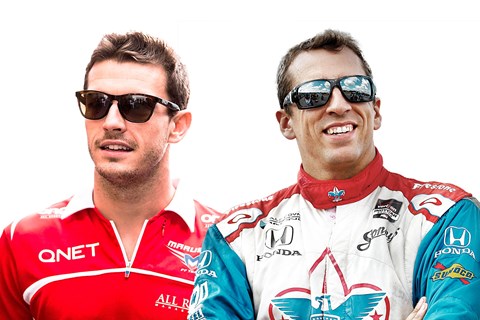► Two men have recently died in motorsport
► Safety race to end motorsport tragedies
► F1 and Indy, who will win the race?
F1 and Indy – what’s the difference?
They’re both open-wheeled and powered by turbocharged V6 engines, but F1 and Indy are quite different. While F1 manufacturers design and build their own cars, Indy teams race machines featuring the same Dallara chassis and a Honda or Chevrolet engine. Not all Indy racing is on ovals. Some takes place on conventional racing circuits, some on street circuits.
Which is more dangerous?
Eight drivers have died in the US series in the last 20 years, including 37-year-old Brit Justin Wilson, who last month succumbed to injuries sustained when a piece of debris from a crash ahead hit his helmet during a race at Pocono, Pennsylvania. In contrast, Marussia driver Jules Bianchi, who collided with a recovery vehicle at the 2014 Japanese GP, was the first to die as a result of taking part in an F1 race since Ayrton Senna in 1994.
‘IndyCar is more dangerous than F1, and that includes the Indy road courses, as the track safety isn’t on par with modern F1 tracks,’ says British racing driver Alex Lloyd, who placed fourth in the 2010 Indinapolis 500. ‘You strap in and you feel more vulnerable, you understand the risk is greater. But it’s also the greatest rush imaginable. No road course can simulate entering a turn at 220+mph, cars inches apart. We need to maintain the spectacle, but we need to protect the drivers.’
What’s been done recently to improve safety?
Both F1 and Indy use tough carbon chassis tubs, and it’s this technology that kept Robert Kubica alive after his 2007 crash, and left Indy racer James Hinchcliffe with little more than a leg wound when he crashed his car into the wall in May at over 200mph. Formula 1 has improved run-off areas at dangerous corners like Monza’s Parabolica, and all four oval tracks on the 2015 Indy calendar are fitted with deformable walls on all curves.
Both sports demand HANS devices and tethers to stop wheels breaking off and hitting other drivers (Henry Surtees, son of F1 champ John, was killed by a loose wheel in 2009), but the pressing concern in both sports remains the drivers’ exposed heads. F1’s Felipe Massa was seriously injured when debris punctured his helmet in 2009, and Indy’s Dan Wheldon and Justin Wilson both died as a result of head injuries. IndyCar has been looking into closed cockpits, but done no testing; the FIA, the motorsport body that governs F1 (but not Indy), has already tested fighter-jet-style canopies.
What’s stopping canopies from appearing on cars?
Several things. There are some concerns that drivers may end up trapped in upturned cars and unable to climb out, or that debris might be bounced into the path of other vehicles. One possible solution is a halo-like cage, demonstrated as a concept by Mercedes last month, that offers some protection and is hinged for access. There’s also some resistance from fans and even some drivers, who see the open cockpits as a link with tradition, despite the fact that you can see almost nothing of the driver.
But according to motorsport broadcaster and journalist Marshall Pruett, who covers both F1 and Indy in the US, it’s not a matter of if head protection will come, but when. ‘I don’t think there’s been a lack of safety – if that debris had landed an inch to either side, Justin Wilson would still be with us – but I do think there’s been a lack of urgency to get to the next safety advancement until now. I don’t know whether it’ll be a fighter-style cockpit canopy or something like the Mercedes proposal, but it’s coming. I don’t think Indy or F1 can survive any more head strikes.’
If closed cockpits are inevitable, who will get there first, F1 or Indy?
The FIA is rich and powerful, Indycar is a self-regulating body with far less cash, but will now receive the results of the FIA research. F1 cars will get the tech first, likely in the next 2-3 years according to Pruett. ‘With Indy it’s like F3; they’ll mobilise to make changes, but it’s going to take longer.’
The men who died
Jules Bianchi and Justin Wilson are the latest drivers to lose their lives in F1 and Indy. Both sports want them to be remembered as the last to die. Frenchman Bianchi, 25, lay in a coma from his crash at Suzuka in October 2014 until his death in July this year. Wilson crashed on 23 August, and died a day later.
